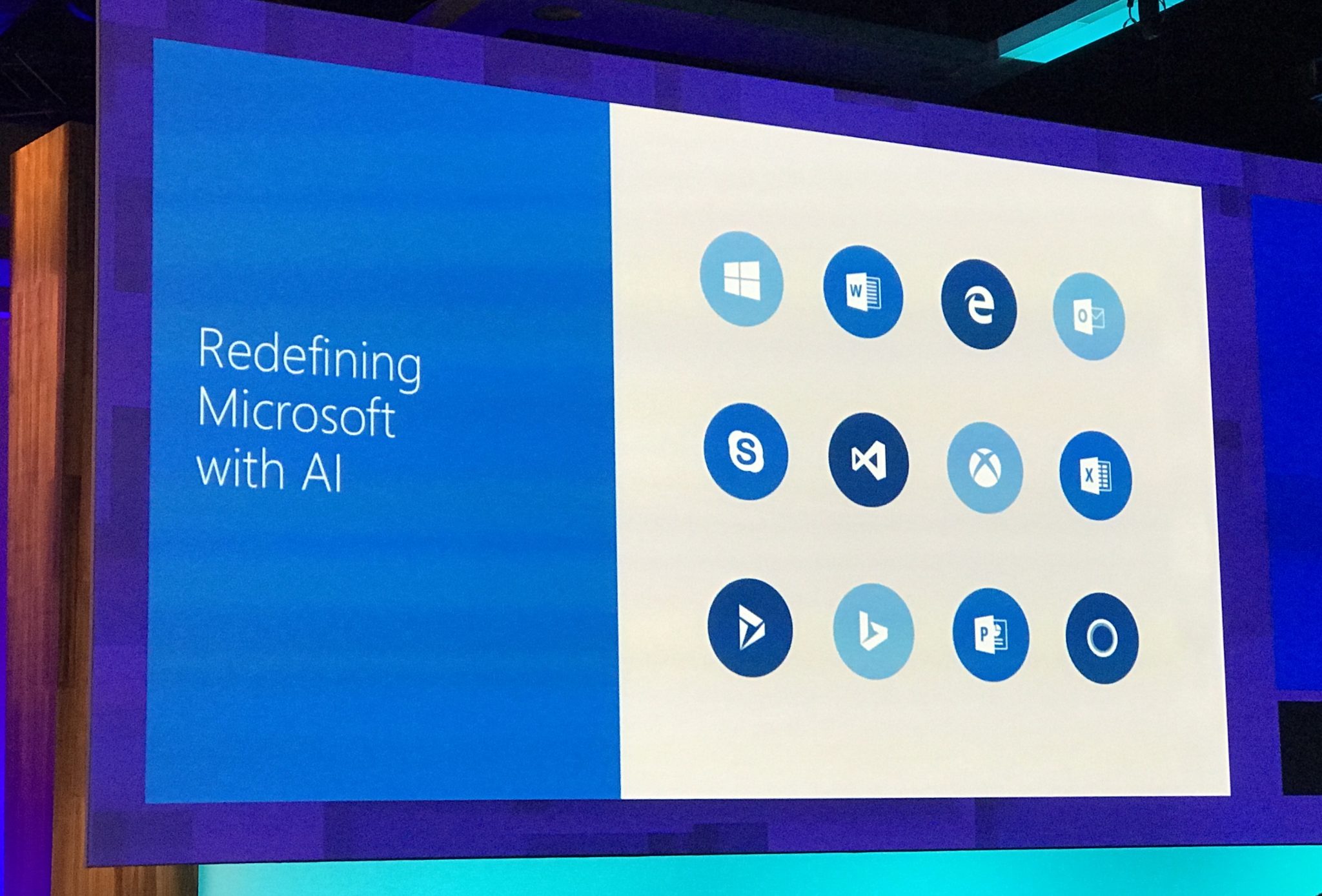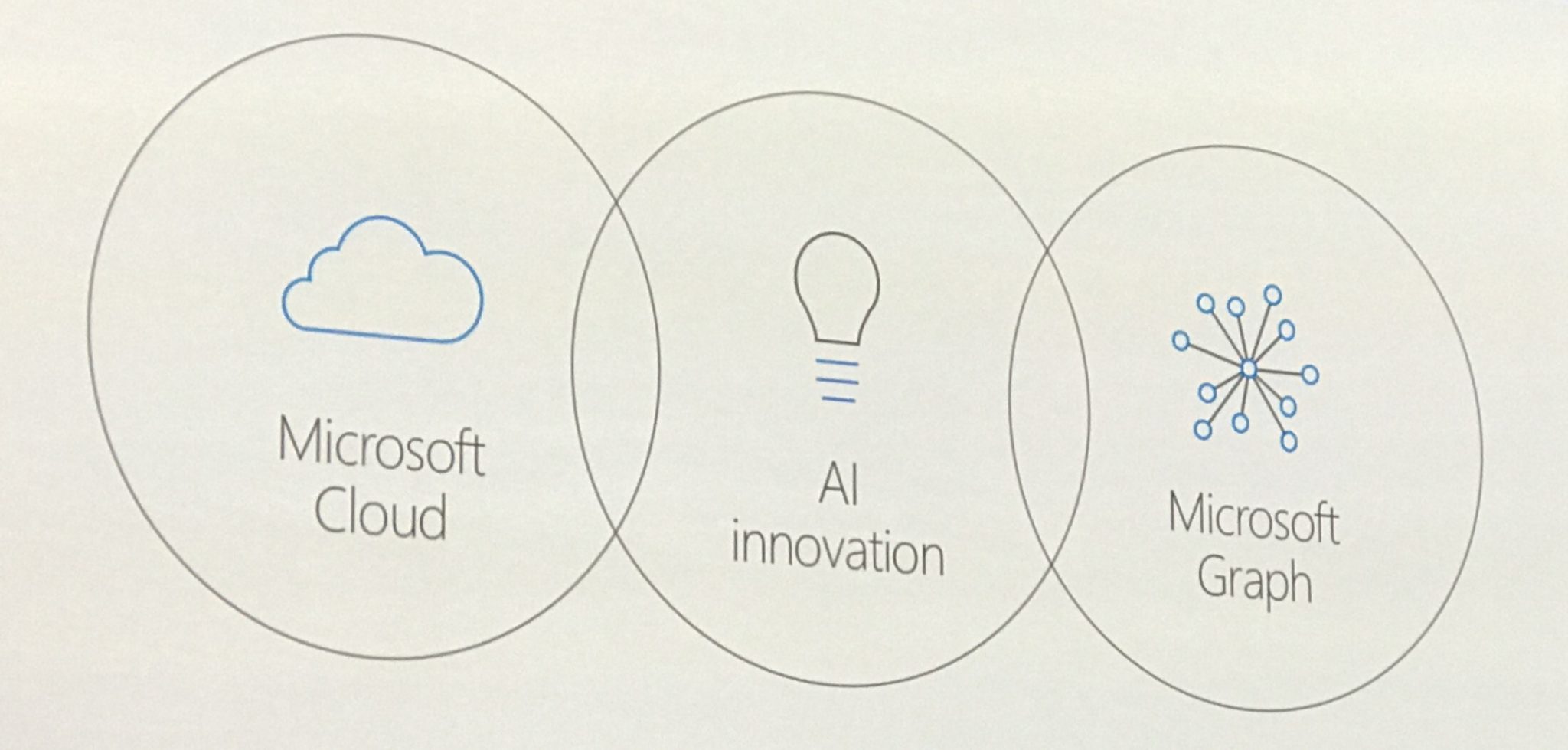[caption id="attachment_141638" align="aligncenter" width="3230"]

A.I. is key for Microsoft[/caption] Build 2017 is surfacing a new truth for Microsoft: artificial intelligence (A.I.) is how the company thinks we’ll interact with computers, smartphones and maybe even each other in the future. This approach to A.I. is familiar. Microsoft is positioning the technology as an enterprise feature that will spill over into our day-to-day lives. The last time it pushed some piece of technology hard on the enterprise-to-consumer front, we got Office, which is now unavoidable. Microsoft’s A.I. platform, Cortana, is typically regarded as a speech-heavy digital assistant. Past Build conferences brought us Cortana as a voice interface, the same place that Amazon positions Alexa. Now, Microsoft wants us to consider Cortana as – well, everything. There’s a lot under the hood. Last year, Build brought us bots. If you’ve developed or used a bot, you know they’re simplistic A.I. for quick interactions. A bot may be able to tell you the weather, but once it does more – such as predict your drive time based on traffic and where you typically go in the morning – it becomes something closer to A.I.

Microsoft seems to think it’s time to turn the corner on bots, though it hasn’t stopped investing in the platform. Bots can now interact with Skype and Teams, and Microsoft seems to be positioning them as introductory pieces for developers interested in A.I. or machine learning. Its bot framework also ties into a long list of APIs to make them “smarter.” Those APIs are key for the company and its A.I. efforts. Everything filters through Azure (and possibly Graph). Those who aren’t quite ready to be cutting-edge can tap into
Cognitive Services Lab, an exchange for applications using contextual intelligence; it's a step beyond bots. Here’s how the company describes it:
Microsoft Cognitive Services Labs are a set of APIs, SDKs and services available to developers to make their applications more intelligent, engaging and discoverable. Microsoft Cognitive Services Labs expands on Microsoft’s evolving portfolio of machine learning APIs and enables developers to easily add intelligent features into their applications. Our vision is for more personal computing experiences and enhanced productivity aided by systems that increasingly can see, hear, speak, understand and even begin to reason.
It’s one piece of the A.I., but an important one. Azure is also critical, and increasingly where Microsoft is placing emphasis. At this point,
Azure touches everything that Microsoft does. APIs flow through there, and the company’s version of Apple's Handoff – picking up on one device where you left off on another – leans into Azure for the transition. As Microsoft writes: “With Cortana, you can Pick Up Where You Left Off across Windows, iOS and Android devices.” It’s a good example of Azure’s subtle strength and how Microsoft views Cortana.

Cortana, A.I. and Azure are becoming one and the same. Cortana is the interface, APIs provide data, and Azure shuttles packets of data around. It’s seamless for users, which is the point. One day, “Cortana” may just
feel smarter than other A.I. assistants, but it won’t be solely because of one killer service. APIs play an important role here. Serviceable for developers, they also filter a
ton of data through Azure. It’s a democratized way of improving a network of tools, and faster than a solo effort on Microsoft’s part. This is a sensible approach. Nothing about Microsoft’s A.I. goals feel out of touch this year. Last year, its bots seemed late to the game and a bit tiresome. Azure wasn’t nearly as integral as now. But a lingering problem is the number of people using Cortana: by Microsoft’s count, only about 28 percent of Windows users tap into Cortana monthly – and that’s counting all interactions. Perhaps fixing its intelligence will boost those numbers. The problem with A.I. has always been its one-off nature. Sure, it may guess my drive time to work based on traffic, but that’s easy logic. Asking a bot the weather has always been clumsier than a widget or opening an app. In weaving services and interactions together with a solid cloud-based platform, Microsoft is helping us feel like A.I. is finally getting smart.
 A.I. is key for Microsoft[/caption] Build 2017 is surfacing a new truth for Microsoft: artificial intelligence (A.I.) is how the company thinks we’ll interact with computers, smartphones and maybe even each other in the future. This approach to A.I. is familiar. Microsoft is positioning the technology as an enterprise feature that will spill over into our day-to-day lives. The last time it pushed some piece of technology hard on the enterprise-to-consumer front, we got Office, which is now unavoidable. Microsoft’s A.I. platform, Cortana, is typically regarded as a speech-heavy digital assistant. Past Build conferences brought us Cortana as a voice interface, the same place that Amazon positions Alexa. Now, Microsoft wants us to consider Cortana as – well, everything. There’s a lot under the hood. Last year, Build brought us bots. If you’ve developed or used a bot, you know they’re simplistic A.I. for quick interactions. A bot may be able to tell you the weather, but once it does more – such as predict your drive time based on traffic and where you typically go in the morning – it becomes something closer to A.I.
A.I. is key for Microsoft[/caption] Build 2017 is surfacing a new truth for Microsoft: artificial intelligence (A.I.) is how the company thinks we’ll interact with computers, smartphones and maybe even each other in the future. This approach to A.I. is familiar. Microsoft is positioning the technology as an enterprise feature that will spill over into our day-to-day lives. The last time it pushed some piece of technology hard on the enterprise-to-consumer front, we got Office, which is now unavoidable. Microsoft’s A.I. platform, Cortana, is typically regarded as a speech-heavy digital assistant. Past Build conferences brought us Cortana as a voice interface, the same place that Amazon positions Alexa. Now, Microsoft wants us to consider Cortana as – well, everything. There’s a lot under the hood. Last year, Build brought us bots. If you’ve developed or used a bot, you know they’re simplistic A.I. for quick interactions. A bot may be able to tell you the weather, but once it does more – such as predict your drive time based on traffic and where you typically go in the morning – it becomes something closer to A.I.  Microsoft seems to think it’s time to turn the corner on bots, though it hasn’t stopped investing in the platform. Bots can now interact with Skype and Teams, and Microsoft seems to be positioning them as introductory pieces for developers interested in A.I. or machine learning. Its bot framework also ties into a long list of APIs to make them “smarter.” Those APIs are key for the company and its A.I. efforts. Everything filters through Azure (and possibly Graph). Those who aren’t quite ready to be cutting-edge can tap into Cognitive Services Lab, an exchange for applications using contextual intelligence; it's a step beyond bots. Here’s how the company describes it:
Microsoft seems to think it’s time to turn the corner on bots, though it hasn’t stopped investing in the platform. Bots can now interact with Skype and Teams, and Microsoft seems to be positioning them as introductory pieces for developers interested in A.I. or machine learning. Its bot framework also ties into a long list of APIs to make them “smarter.” Those APIs are key for the company and its A.I. efforts. Everything filters through Azure (and possibly Graph). Those who aren’t quite ready to be cutting-edge can tap into Cognitive Services Lab, an exchange for applications using contextual intelligence; it's a step beyond bots. Here’s how the company describes it:
 Cortana, A.I. and Azure are becoming one and the same. Cortana is the interface, APIs provide data, and Azure shuttles packets of data around. It’s seamless for users, which is the point. One day, “Cortana” may just feel smarter than other A.I. assistants, but it won’t be solely because of one killer service. APIs play an important role here. Serviceable for developers, they also filter a ton of data through Azure. It’s a democratized way of improving a network of tools, and faster than a solo effort on Microsoft’s part. This is a sensible approach. Nothing about Microsoft’s A.I. goals feel out of touch this year. Last year, its bots seemed late to the game and a bit tiresome. Azure wasn’t nearly as integral as now. But a lingering problem is the number of people using Cortana: by Microsoft’s count, only about 28 percent of Windows users tap into Cortana monthly – and that’s counting all interactions. Perhaps fixing its intelligence will boost those numbers. The problem with A.I. has always been its one-off nature. Sure, it may guess my drive time to work based on traffic, but that’s easy logic. Asking a bot the weather has always been clumsier than a widget or opening an app. In weaving services and interactions together with a solid cloud-based platform, Microsoft is helping us feel like A.I. is finally getting smart.
Cortana, A.I. and Azure are becoming one and the same. Cortana is the interface, APIs provide data, and Azure shuttles packets of data around. It’s seamless for users, which is the point. One day, “Cortana” may just feel smarter than other A.I. assistants, but it won’t be solely because of one killer service. APIs play an important role here. Serviceable for developers, they also filter a ton of data through Azure. It’s a democratized way of improving a network of tools, and faster than a solo effort on Microsoft’s part. This is a sensible approach. Nothing about Microsoft’s A.I. goals feel out of touch this year. Last year, its bots seemed late to the game and a bit tiresome. Azure wasn’t nearly as integral as now. But a lingering problem is the number of people using Cortana: by Microsoft’s count, only about 28 percent of Windows users tap into Cortana monthly – and that’s counting all interactions. Perhaps fixing its intelligence will boost those numbers. The problem with A.I. has always been its one-off nature. Sure, it may guess my drive time to work based on traffic, but that’s easy logic. Asking a bot the weather has always been clumsier than a widget or opening an app. In weaving services and interactions together with a solid cloud-based platform, Microsoft is helping us feel like A.I. is finally getting smart. 
